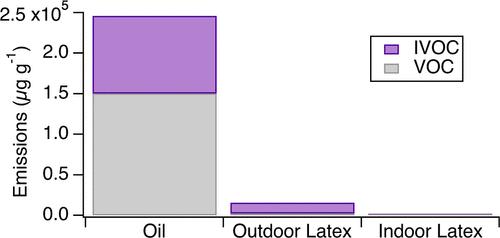当前位置:
X-MOL 学术
›
Environ. Sci. Technol.
›
论文详情
Our official English website, www.x-mol.net, welcomes your
feedback! (Note: you will need to create a separate account there.)
Watching Paint Dry: Organic Vapor Emissions from Architectural Coatings and their Impact on Secondary Organic Aerosol Formation
Environmental Science & Technology ( IF 10.8 ) Pub Date : 2022-08-05 , DOI: 10.1021/acs.est.2c02478 Rebecca Tanzer-Gruener 1 , Pavithra Ethi Rajan 1 , Liam D Dugan 2 , Mark E Bier 2 , Allen L Robinson 1 , Albert A Presto 1
Environmental Science & Technology ( IF 10.8 ) Pub Date : 2022-08-05 , DOI: 10.1021/acs.est.2c02478 Rebecca Tanzer-Gruener 1 , Pavithra Ethi Rajan 1 , Liam D Dugan 2 , Mark E Bier 2 , Allen L Robinson 1 , Albert A Presto 1
Affiliation

|
Emissions from volatile chemical products (VCPs) are emerging as a major source of anthropogenic secondary organic aerosol (SOA) precursors. Paints and coatings are an important class of VCPs that emit both volatile and intermediate volatility organic compounds (VOCs and IVOCs). In this study, we directly measured I/VOC emissions from representative water- (latex) and oil-based paints used in the U.S. Paint I/VOC emissions vary by several orders of magnitude by both the solvent and gloss level. Oil-based paints had the highest emissions (>105 μg/g-paint), whereas low-gloss interior paints (Flat, Satin, and Semigloss) all emitted ∼102 μg/g-paint. Emissions from interior paints are dominated by VOCs, whereas exterior-use paints emitted a larger fraction of IVOCs. Extended emission tests showed that most I/VOC emissions occur within 12–24 h after paint application, though some paints continue to emit IVOCs for 48 h or more. We used our data to estimate paint I/VOC emissions and the subsequent SOA production in the U.S. Total annual paint I/VOC emissions are 48–155 Gg (0.15–0.48 kg/person). These emissions contribute to the formation of 2.2–7.5 Gg of SOA annually. Oil-based paints contribute 70–98% of I/VOC emissions and 61–99% of SOA formation, even though they only account for a minority of paint usage.
中文翻译:

观察油漆干燥:建筑涂料的有机蒸气排放及其对二次有机气溶胶形成的影响
挥发性化学产品 (VCP) 的排放正在成为人为二次有机气溶胶 (SOA) 前体的主要来源。油漆和涂料是一类重要的 VCP,它们会释放挥发性和中等挥发性有机化合物(VOC 和 IVOC)。在这项研究中,我们直接测量了美国油漆中使用的代表性水基(乳胶)和油基涂料的 I/VOC 排放量,其溶剂和光泽度的差异有几个数量级。油性涂料的排放量最高(>10 5 μg/g-paint),而低光泽内墙涂料(Flat、Satin 和 Semigloss)的排放量均约为10 2微克/克涂料。室内涂料的排放物以 VOC 为主,而外用涂料的 IVOC 排放量更大。扩展排放测试表明,大多数 I/VOC 排放发生在油漆应用后 12-24 小时内,尽管一些油漆继续排放 IVOC 48 小时或更长时间。我们使用我们的数据来估算美国油漆 I/VOC 排放量和随后的 SOA 产量 年度油漆 I/VOC 总排放量为 48–155 Gg(0.15–0.48 kg/人)。这些排放导致每年形成 2.2-7.5 Gg SOA。油性涂料贡献了 70-98% 的 I/VOC 排放和 61-99% 的 SOA 形成,尽管它们只占涂料使用的一小部分。
更新日期:2022-08-05
中文翻译:

观察油漆干燥:建筑涂料的有机蒸气排放及其对二次有机气溶胶形成的影响
挥发性化学产品 (VCP) 的排放正在成为人为二次有机气溶胶 (SOA) 前体的主要来源。油漆和涂料是一类重要的 VCP,它们会释放挥发性和中等挥发性有机化合物(VOC 和 IVOC)。在这项研究中,我们直接测量了美国油漆中使用的代表性水基(乳胶)和油基涂料的 I/VOC 排放量,其溶剂和光泽度的差异有几个数量级。油性涂料的排放量最高(>10 5 μg/g-paint),而低光泽内墙涂料(Flat、Satin 和 Semigloss)的排放量均约为10 2微克/克涂料。室内涂料的排放物以 VOC 为主,而外用涂料的 IVOC 排放量更大。扩展排放测试表明,大多数 I/VOC 排放发生在油漆应用后 12-24 小时内,尽管一些油漆继续排放 IVOC 48 小时或更长时间。我们使用我们的数据来估算美国油漆 I/VOC 排放量和随后的 SOA 产量 年度油漆 I/VOC 总排放量为 48–155 Gg(0.15–0.48 kg/人)。这些排放导致每年形成 2.2-7.5 Gg SOA。油性涂料贡献了 70-98% 的 I/VOC 排放和 61-99% 的 SOA 形成,尽管它们只占涂料使用的一小部分。









































 京公网安备 11010802027423号
京公网安备 11010802027423号